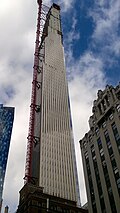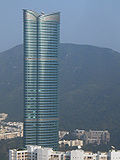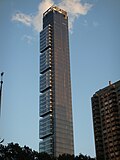Please don’t
bite me, I’m a newbie!
I’m a university student in a
Wikipedia Education class, and I’m currently learning how to contribute to Wikipedia.
This page is a work in progress and I am approaching my subject in
good faith.
Thanks!
Skinny or slender skyscraper is the tall buildings with a height-to-base ratio higher than 1:10 or 1:12. [1] Skinny skyscrapers can be used for commercial office buildings or residential buildings space, or with multiple purposes combined. This type of building came into being because people need it and have enough technology to support it. Skinny skyscraper mostly located in the big cities which has large population and good economic development. As the number of population moves to cities increasingly , cities are asked to extend, not only wider but also higher, in order to meet the larger housing demand. [2]
Slender building logic from expensive, restricted in downtown block to obtain the greatest possible value. [3]
The slenderest skyscraper in the world will complete in 2019, which is The Steinway Tower in Midtown Manhattan, with a width-to-height ratio of 1:24, and the height is 435 meters. [4]
In 2013/2014, the skyscraper museum held a "sky high & luxurious logic" exhibition, recording the rise of the Manhattan skinny structure. The slender buildings on display included 432 park avenue, 1,396 feet (425.5 meters) high; One57, also known as the 'billionaire tower' and the special”stacked homes”56 Leonard tower.
[5]
Definition
- Super skinny skyscraper refers to the slenderness of high-rise buildings is greater than 1:10 or 1:12, and the hight to base ratio is defined as slenderness ratio.
- Most skinny skyscrapers are not used for commercial purposes, but for residential use. This new construction style is driven by higher land prices, the scarcity of large tracts of land for construction and demand for high-end apartments.[6]
- The term of the "slenderness" was considered to be a strategy by engineers applied to buildings since 2007, the pioneers of skinny skyscraper are three luxury residential apartments building in New York, they are the One Madison Park,Park Avenue, and Sky House.[4]
- The rise of skinny skyscrapers have changed the skyline of some cities, for example, the famous NEW YORK city's skyline.
- Skinny skyscrapers buildings have undoubtedly promoted the development of modern design, architecture, engineering and real estate. In a city like New York, where space is a commodity, where saving space on the ground increases the available space above, a skinny skyscraper seems like the perfect solution. [6]
Reasons of the rise of Skinny skyscraper
As more and more people migrate to urban areas, to find a buildable land in the city is hard and expensive. In order to overcome this obstacle, architects try to make full use of the small plot, taking advantage of new building materials and engineering innovation to design thin skyscrapers. [7] Skinny skyscrapers was supported by incomplete zoning law, advanced technology as well as a group of people who can afford the much higher housing prices.
Zoning laws
The first reason is New York had complex zoning laws with a loophole. Though laws restrict the number of land that can be built on within an area, the loophole allows "air right " transaction between each land. Therefore, the loophole give developers chance to buy a small piece of land, then buy a lot of air rights from nearby land, having a legal way to set up a tall buliding. For example, if the building is completed, and it did not reach the height it is allowed, the developer of a new nearby building could buy the unused air rights, and stack them to the air rights of their existing plot -- such a transaction is called a "zoning lot merger." [4]
Technology
Technological advancements is another key factor to motivate the rise of the skinnies. Engineers and architects gain more confidences to build new shape and structure system recent years, thanks to the improvements in composite materials, computer-assisted design methods, and damping systems to reduce wind-induced motion in tall buildings. Those advanced technology offer engineers a wider range to realise their imagination, architects also got more support to complete the new building design. [8]
Economics
Economic factor is the indispensable reason of skinny skyscraper. The drive for skinny skyscraper is driven by a number of factors, chief among them strong demand for high-end housing that is willing to pay a higher price for a high-rise urban landscape. In other words, the height is valuable in the modern society. In New York, the One57 had the most expensive apartment sales ever in the city, and One57 is one of the Skinny skyscrapers. [9] As skinny skyscrapers could return higher profits to developers, other developers also want maximum their profits, skinny skyscraper will set up continuously.
The Challenge of Building Skinny skyscrapers
1.Technology challenge
Skinny skyscrapers has high requirement of the structure and engineer innovation, as they have series of serious problems need to be consider, including the effects of wind pressure and turbulence, building stability, enable the development of new building technologies, simplify construction, and reduce costs. If a skinny skyscraper wants to operate or set up efficiently and sustainably, it also requires working with mechanical and electrical and plumbing (MEP) engineers . [10]
The wind flow of a building higher than 1000 feet is similar to that a plane needs to experience. To reduce the movement of a building to a tolerable level is one of challenges that structural engineers have. This challenge increases with the height of the building. [10]Especially for luxury residential towers, where has high-end components ,comfort level is stricter than for commercial buildings.
The building’s top may tend to sway, as long as the building is higher and slimmer. According to consulting engineers Rowan Williams Davies and Irwin, a tower 1,000 feet tall might move a couple of inches,after a breezy day. A building with this size may move by a 50-mile-per-hour wind about half a foot once a year. While such movement does not poses safety risk and is often difficult to detect, it will make some people dizzy. In order to guarantee the safety of the skinny buildings, developers normally install giant counterweights, or dampening systems, at its spire to counteract the movement of the building. [11]
Tuned mass dampers, made of steel or concrete, weigh between 300 and 800 tons and are mounted on other mechanical equipment on top of buildings. A typical system can take up about 1,000 square feet of space and use a two-story ceiling. The dampers are connected to the walls of the building by a system of pistons and spring supports, like a giant shock absorber that pulls the building back into place whenever a strong wind blows. [11] Another type of shock absorber, called a slosh damper or slosh tank, it uses tons of water instead of steel to add weight to the top of a building. [11]
Adjusting the shape of the building, make its more aerodynamic can solve some problems. For example, by opening to let the wind through, or increasing curve or Angle in the facade of the key position, in order to minimise the vortex shedding can lead to high acceleration response [10].
The structural engineer must work closely with the architect to refine the shape of the building based on detailed wind load analysis. In addition, the high strength concrete could help to achieve a greater stiffness of the building without impeding the layout. [10]
2.Public challenge
Aside from the technical challenges, there are some challenges that come from public opinions. Due to the height of skinny skyscrapers it may affect the building on the surrounding community. [7]
More development is problematic in dense urban environments that many believe are already overbuilt. Considering that one of the functions of the slender skyscraper is to utilise the site for other types of development, these structures can be considered as filling to the extreme. [10]
People who hold the opposite opinion think that adding more people to crowded city streets and sidewalks is a problem, the high rise building often block the street sky and block air flow. Skyscrapers buildings also have a tendency to blow strong winds to the ground, which can affect the comfort and safety of people on sidewalks and squares. [10]
History of slenderness in New York
The birthplace of the skinny skyscrapers is New York city, at the beginning of the 20 centuries, a plenty of tall shafts were erected in high-priced areas. Factors including expensive land prices, technology like elevator and steel-cage construction, provide the chance to create New York city of skyscrapers. [12]
There are three main stages in the New York style of slender high-rise history. [12]
The first was a period of skyrocketing growth when, until the passage of the city's first zoning law in 1916, no municipal regulations constrained height. By 1909, the Metropolitan Life Insurance Tower rose 700 feet - 50 storeys - on a lot only 75 x 85 ft. [12]
The first was a period of rapid growth until 1916, when the city passed its first section of district law, with no municipal regulations limiting height. [12]
The second was in the 1920s. According to the volume formula stipulated in the 1916 zoning law, a building with a huge pyramid base and slender high-rise tower, covering no more than 25% of the land area, has become New York’ s new skyscraper style. [12]
Zoning laws applied to commercial buildings after 1916. Hotel that located at the Fifth Avenue at the southeast corner of central park began to build slender building. Pierre and Shirley's Dutch landscape showcases the enduring appeal of park views in New York's luxury life, heralding the new residential towers of the 21st century. [12]
The height of the building was limited by a zoning law in 1961, to be specific, imposed a maximum total floor area permitted on a given lot, measure by a new formula, called the Floor Area Ratio. This law allows owners to build any level they want, they just need to follow zoning rules, and do not build much higher than permitted. Creating a new concept at same time, developers buy those unused air right to add them together, getting a higher building, therefore, a lot of unused "air rights" to be sold next door to a lot of owners. [12]
Top Five Skinny Skyscraper
-
1.Steinway 111 west 57th street
-
2. Highcliff
-
4.432 Park Avenue
-
5.One Madison
1. 111 West 57th Street
The Steinway Tower at 111 West 57th Street in Manhattan. Completed in 2019, the 1,428-foot-tall (435-meter-tall) building, the slenderest skyscraper in the world, with a width-to-height ratio of 1:24.
2. Highcliff
Highcliff is located in Hong Kong, its slenderness ratio is 1:20, 72 stories and 828 feet (252 meters). Hong Kong's tall buildings have a common characteristic, that is they have extreme slenderness of building, the city has more pencil-thin towers than any place in the world. Hong Kong has high land values and liberal zoning laws, prompted some extraordinarily slender and dense apartment building . [13]
3. Collins House
Collins House and located at 466 Collins Street in Melbourne, it is 195 metres tall and 12 metres wide.It will be one of the world’s skinniest, with with a height-to-width ratio of 13.2:1. [14]
4. 432 Park Avenue
432 Park Avenue a residential skyscraper in New York City, and it is the tallest residential building in the world.
As an example of the logic of luxury, the tower's height is based on its compact 93 square feet. It’s slenderness ratio is 1:15. A striking white grid of concrete frames by Rafael Vinoly, divided into six sections by an open mechanical floor, represents a blend of elegant architectural concepts and structural logic that set 432 park avenue apart from its contemporary curtain wall. [15]
5. One Madison Park
One Madison is a luxury residential condominium tower located on 23rd Street of Manhattan in New York City. The cross-section of One Madison's tower is 50 ft x 53 ft (15.25 m x 16.15 m), at the height of 621 feet (189.3 m). Therefore it is described as a slender tower with a height-to-width ratio of 12:1, one of the slenderest buildings in New York City. [16]
Skinny skyscrapers have changed the skyline
Skyline refers to the overall outline of a city formed by skyscrapers in the city. The term "sky line in New York City" first appeared in 1896 as the title of Charles graham's color lithography for the color supplement of the New York magazine. Getting slimmer is the new look of these skyscrapers on this famous skyline. [17]

References List
- ^ "The Skyscraper Museum: SKY HIGH & the logic of luxury WALKTHROUGH". www.skyscraper.org. Retrieved 2019-05-07.
- ^ "Signing into eresources, The University of Sydney Library". login.ezproxy1.library.usyd.edu.au. Retrieved 2019-05-07.
- ^ "Structural Marvels Make New York's Super-Slender Towers Possible | WSP". www.wsp.com. Retrieved 2019-05-12.
- ^ a b "Signing into eresources, The University of Sydney Library". login.ezproxy1.library.usyd.edu.au. Retrieved 2019-05-07.
-
^ CNN, Andrea Lo (2018-02-12).
"The dramatic changes in New York's skyline". CNN Style. Retrieved 2019-05-12.
{{ cite web}}:|last=has generic name ( help) - ^ Berger, Bennat (2016-08-07). "Skinny Skyscrapers: A Trend That's Here to Stay?". Medium. Retrieved 2019-05-27.
- ^ a b "Trends in Architecture: The Rise of Super Skinny and Super Tall Skyscrapers | Fenner-Esler". Retrieved 2019-05-21.
- ^ "Signing into eresources, The University of Sydney Library". login.ezproxy1.library.usyd.edu.au. Retrieved 2019-05-12.
- ^ "Signing into eresources, The University of Sydney Library". login.ezproxy1.library.usyd.edu.au. Retrieved 2019-05-12.
- ^ a b c d e f "Skinny skyscrapers". Civil + Structural Engineer magazine. Retrieved 2019-05-21.
- ^ a b c Higgins, Michelle (2015-08-07). "Keeping Skyscrapers From Blowing in the Wind". The New York Times. ISSN 0362-4331. Retrieved 2019-05-12.
- ^ a b c d e f g "NEW YORK'S SUPER-SLENDERS". www.skyscraper.org. Retrieved 2019-05-27.
- ^ "Presented by The Skyscraper Museum". www.skyscraper.org. Retrieved 2019-05-12.
- ^ "Melbourne's next 'pencil tower'". ArchitectureAU. Retrieved 2019-05-12.
- ^ "NEW YORK'S SUPER-SLENDERS". www.skyscraper.org. Retrieved 2019-05-12.
- ^ "One Madison Park - The Skyscraper Center". www.skyscrapercenter.com. Retrieved 2019-05-12.
-
^ CNN, Andrea Lo (2018-02-12).
"The dramatic changes in New York's skyline". CNN Style. Retrieved 2019-05-16.
{{ cite web}}:|last=has generic name ( help)
See Also
External links
- https://www.skyscraper.org/EXHIBITIONS/TEN_TOPS/slender.php
- http://www.wsp-pb.com/en/High-Rise/High-Rise-Insights/The-Super-Slender-Revolution/
Category:Skyscrapers Category:Architectural terminology Category:City Category:Skyscrapers Category:Cityscapes Category:Architecture



![As an example of the logic of luxury, the tower's height is based on its compact 93 square feet. It’s slenderness ratiois 1:15. A striking white grid of concrete frames by Rafael Vinoly, divided into six sections by an open mechanical floor, represents a blend of elegant architectural concepts and structural logic that set 432 park avenue apart from its contemporary curtain wall.[11]](https://upload.wikimedia.org/wikipedia/commons/thumb/1/1b/432_Park_Avenue%2C_NY_%28cropped%29.jpg/120px-432_Park_Avenue%2C_NY_%28cropped%29.jpg)

